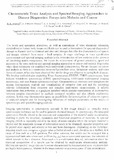| dc.description.abstract | The levels and speciation alterations, as well as correlations of trace chemicals (elements,
metabolites) in human body tissues and fluids can be used as biomarkers for spectral diagnosis of
disease as diseases lead to chemical and structural changes that alter the characteristics of spectra
and images obtained from tissue / fluid samples. A major challenge in trace quantitative
spectroscopic and spectral imaging analysis is the determination of low analytes in the presence
of interfering matrix components. We report the achievement of greater sensitivity, speed and
accuracy inthe trace analysis and spectral imaging approaches to cancer and malaria diagnostics
when these techniques are combined with multivariate chemometrics. We are focused on cancer
and malaria as there is a connection between Epstein-Barr virus, falciparum malaria, and some
forms of cancer; it has also been observed that similar drugs are effective in curing both diseases.
We develop methodologies exploiting X-ray fluorescence (EDXRF, TXRF) spectroscopy, laser
induced breakdown spectroscopy (UBS) spectral/imaging, LED-based multispectral imaging
microscopy, and laser Raman spectromicroscopy. Chemometrics is relatively new disciplines for
mining (management, analysis and visualization) of extensive data sets and for extracting
relevant information from extensive and complex multivariate measurements. It affords
multivariate data reduction in a graphical interface which permits visualization of relationships
between samples characterized by multiple measured variables and also affords exploratory
analyses. In this way chemometrics opens up possibilities for investigation of unknown aspects
of analyzed samples and for investigating influences of multiple parameters on the results of
spectroscopic and spectral imaging analyses.
Imaging spectrometry is spectroscopy pursued in the image domain as virtually every
spectroscopic technique can be used to generate chemical images. In spectroscopy, the measured
spectrum is directly related to the structure and composition of the material under examination,
enabling to probe the structural, dynamical, and functional properties of materials. In spectral
imaging (which is especially suited to the study of micro-samples where the sample material is
limited and the maximum amOUI4tof information needs to be obtained), material properties can
be probed more rapidly and reliably in two and three dimensions. Depending on the technique,
mapping results may comprise a single value collected at each x and y location on a surface, or a range of data such as a full spec•trum. For either outcome, the results can be arranged into a
hyperspectrar data cube where each position (x., yT)l) has an associated spectrum, the intensity of
which extends in the z direction. Since each z is a multivariate data set, information about the
chemical composition of a sample can be obtained by multivariate chemometric analysis.
Multivariate spectral image data are however characterized by ·measurement error variances that
are highly heterogeneous, inherent in the measurements or as consequence of-data pretreatment. | en_US |

